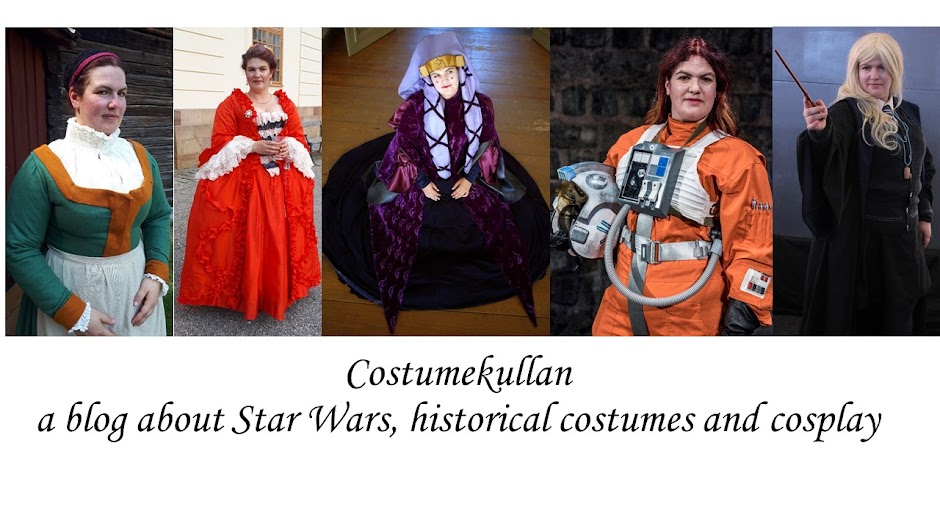In addition to the pocket itself being a garment that's supposed to be unseen and secret it hides three different secrets.
First off for the fabric I had gotten a bunch of stuff from my sister earlier, among others some curtains and a table cloth. The table cloth had some stains on it that just wouldn't go away, so I had planned to give it away. The town has a collection where you can leave fabric pieces and remnants so that they can be used by in creative projects in preschools. I hadn't had time to do that though, and looking through pictures of surviving garments it was clear that brocades and coloured fabrics so I figured it would be a nice fabric for that, if I dyed it..
This is the original table cloth. I cut out two pieces for the pocket, and tried to find an ornament that could be contained in the pocket.
The result was a gorgeous golden orange colour, that really made the pattern on the fabric pop. Unfortunately me adding some extra brown straight into the dye bath meant that it hadn't quite dissolved and I had some brown spots on the fabric. The first secret of the pocket is that I've hidden those spots under the blue embroidery.
The second secret is that I only used the nice orange silk for the front and a piece of the back. This is the inside of the pocket, where I used a piece of that old curtain my sister had given me. The pocket may look fancy, but most of it is a sturdy cotton/linen blend.
This is the backside, the blue cotton tape that I used to bind the edges make sure that nothing of the simple fabric is seen when it's worn.
The third secret is the embroidery. Looking at extant examples of pockets from the late 18th early 19th century quite a few of them had initials embroidered on them. I embroidered my initials on it, including my middle names so the embroidery says "I M K N". If you can't read those letters it's because they are not in the latin alphabet, they are written in Dalecarlian runes.
Many people know that the vikings used runes for writing. The usage of runes didn't end with the vikings though, quite a few examples of writing with runes have survived from the Middle Ages in Norway and Sweden, in most parts of Scandinavia they disappear in the 15th century though. In Dalarna, the region where I live, the runes didn't only survive, but took on a development of their own. Instead of giving up on the runes when the latin alphabet got more widespread they people around northern Lake Siljan and Älvdalen started to invent runes of their own. The vikings only used 16 runes, but in order to make the writing of runes follow the spelling with the latin alphabet quite a few new runes were created. This is the alphabet that is today called "Dalecarlian runes". The usage of runes around Lake Siljan ended some time in the 17th century, but they survived in the parish of Älvdalen. With time more and more of the runes where switched in favor of latin letters, so that by the end of the 19th century it was more a case of a mixed alphabet. It's generally considered that the last genuine inscription with Dalecarlian runes was written in 1900.
The inscriptions that have survived are inscriptions on wood and stone, I don't know of any embroidered runes. The inscriptions are so diverse though, including psalms and communications between villages, that the knowledge of runes must have been fairly widespread. I don't think it's unlikely that some girl in Älvdalen would have written her initials on a pocket using the familiar runes rather than the latin alphabet.
The facts
What the item is: A pocket
The Challenge: 10 Sewing secrets
What's the Secret?: 1. Only the visible parts are of a nice fabric, the unseen parts are of a simpler fabric. 2. I hid some dye stains with embroidery. 3. I embroidered my initials in Dalecarlian runes, an alphabet that was used at the time but is secret to most people today.
Fabric: 30 cm of a cotton/linen curtain, 30 cm of a damast table cloth
Pattern: My own after extant pockets
Year: 1795 (the specific versions of runes that I used are found on an inscription dated to 1795.
Notions: 2,5 m cotton tape, sewing thread
How historically accurate is it? I would say that it looks like and original but the fabric was dyed with modern methods and I haven't seen any extant textiles with runes on them, so 20% maybe?
Hours to complete: 4
First worn: Not yet
Total cost: All from my stash, and the fabric was gifted to me so really nothing.








This comment has been removed by a blog administrator.
ReplyDelete